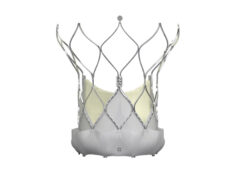
Anna Franzone (Department of Cardiology, Swiss Cardiovascular Center, University Hospital, Bern, Switzerland) and others report in the JACC: Cardiovascular Interventions that transcatheter aortic valve implantation (TAVI) is a technically feasible approach for managing patients with aortic regurgitation who are high risk for surgery. They add TAVI in this group of patients is associated with an “acceptable risk of early mortality”.
According to Franzone et al, TAVI for the treatment of native pure aortic regurgitation “imposes some unique challenges”. For example, they state: “In contrast to aortic stenosis, the absence of valvular calcification in the majority of patients with native pure aortic regurgitation complicates anchoring of the transcatheter valve prosthesis within the annular plane”. The authors add that the annulus of patients with aortic regurgitation is “typically increased and may exceed the range of commercially available transcatheter valve prosthesis”.
However, they state that there is a rationale for using TAVI in these patients as the Euro Heart Survey found that “only one in five patients with severe aortic regurgitation and left ventricular fraction below 30% to 50% were referred to surgery”. Furthermore, according to this survey, only 3% of patients with aortic regurgitation and left ventricular fraction below 30% were referred to surgery. Therefore, as reports of TAVI being used to treat patients with aortic regurgitation have accumulated, Franzone et al performed a systematic literature review and meta-analysis of studies to examine the clinical outcomes of patients with aortic regurgitation who have undergone TAVI.
They identified, from 13 reports, 237 patients with aortic regurgitation who had undergone TAVI (mean logistic EuroScore ranged from 15.3±8% to 34±8.4%). Of these, 79% received a self-expanding prosthesis and 21% received a balloon-expandable device. However, less than a quarter of patients (51) underwent TAVI with the only device that has the CE mark for aortic regurgitation—JenaValve. “Rates of the primary endpoint, all-cause mortality at 30 days, ranged from 0% up to 30% with a summary estimate of 7%. There were no events of myocardial infarction at 30 days; stroke or transient ischaemic attack ranged from 0% to 5% with a summary estimate of 0 (0–1),” the authors report. They add that pacemaker implantation rates ranged from 0% to 44% (summary estimate of 11%) and moderate or severe aortic postprocedural aortic regurgitation was “up to 88%” with a summary estimate rate of 9%.
In the subgroup of patients who received the JenaValve device, 30-day mortality was 11%, permanent pacemaker rate was 6%, and residual moderate to severe aortic regurgitation was, according to Franzone et al, “exceedingly rate”.
Concluding their study, the authors state: “The results of this study support the technical feasibility of TAVI for the treatment of high-risk patients with a relatively low rate of early adverse events. However, despite initial encouraging data, larger studies, longer follow-up and further development in device technology are necessary to advance the expansion of TAVI to patients with pure native aortic regurgitation.”
Study author Thomas Pilgrim (Department of Cardiology, Swiss Cardiovascular Center, University Hospital, Bern, Switzerland) told Cardiovascular News: “I think that TAVI for pure native aortic regurgitation is a valuable treatment option for inoperable patients whereas surgical aortic valve replacement remains the preferred treatment option for the majority of patients at this time.”










